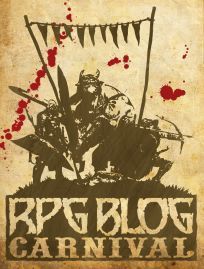
Savage Worlds, though, is another story. Since my lunchtime The Day After Ragnarok game began I’ve written all my notes long hand, which is something I haven’t done since grade school. My initial notebook was a small blue spiral-bound affair from Staples. It took a year to fill (we do only play once or twice a week, and have frequent work-induced breaks) and then I got another heftier one … whose pages immediately began falling out. That’s when I decided to do things right and get a Moleskine notebook. Moleskine notebooks are loved by hipsters and writers … and now I see why. The paper weight is perfect; heavy enough to feel substantial, light enough to yield to your pen. The pages are held together by a strong binding, and the hard cover protects your treasured pages from elemental abuse. An elastic band holds the whole thing together, or serves as a handy bookmark.
The results of this experiment have been immensely satisfying. There’s something primordial (in the sense of being close to the fount of creativity, of physically making something) about writing my adventure notes longhand. It brings to mind long-ago dungeon crawls in grade school, doodling on character sheets, and thick notebooks filled with clues gleaned from computer games like Ultima IV (in the days before in-game journals, you had to keep track of your own damn quests).
Writing longhand also forces contemplation. Typing is easy. Typing is fast. Typing allows you to knock out a dozen pages of adventure notes in an afternoon. Writing longhand requires effort. Forget the machine gun firing of the keyboard, with pen in hand you’re forced to write far more slowly. I’m sure there are speedy longhand writers, but I’m not one of them.
Writing longhand is also messy, at least for left handers like me. Pen, pencil — it doesn’t matter: either way the side of my hand is going to be darkly stained by my efforts. At the same time, the binding of the book often gets in my way unless I decide to write from the back to the front of the book. This is a big problem with spiral-bound notebooks, but it’s less of an issue with the flat-laying Moleskines.
I’ve taken to writing back to front on occasion, partly for logistics and partly for comfort. I write my adventure notes and draw my maps in the front of the Moleskin, but put all the NPCs and magic items at the back of the book. This gives me quick access to essential information, and gives me a break from the inky Curse of the Southpaw.
I find that Savage Worlds is the perfect system for this approach. Stat blocks are generally short – minor NPCs and mundane monsters can fit on a few lines, while major NPCs take up two or three pages at most. Plus the “explorer’s edition” rule books — Savage Worlds, The Day After Ragnarok
and Fantasy Companion — aren’t much bigger than the Moleskine. I can throw all of them in my messenger bag and have my notes and source material with me at all times.
I don’t know what my future will bring with RPGs — I’ve got three more books to run in my Second Darkness campaign for Pathfinder, but when that has run its course I can easily see running a D&D Next or Numenera campaign. As things stand now, both systems could lend themselves to continuing this longhand experiment, and if so, I see a lot more Moleskins in my future.
